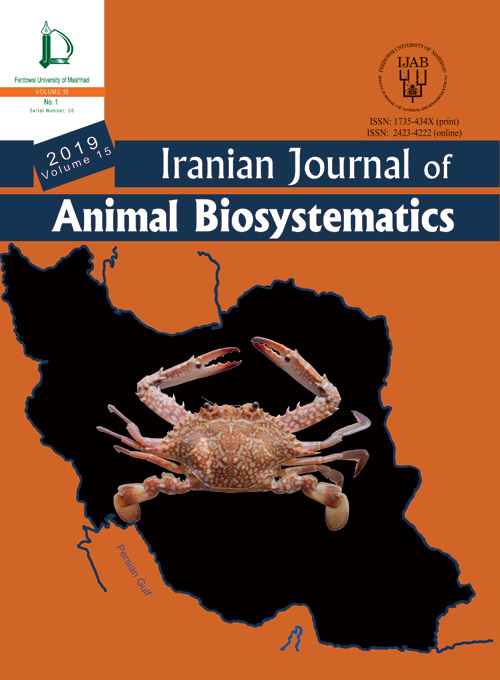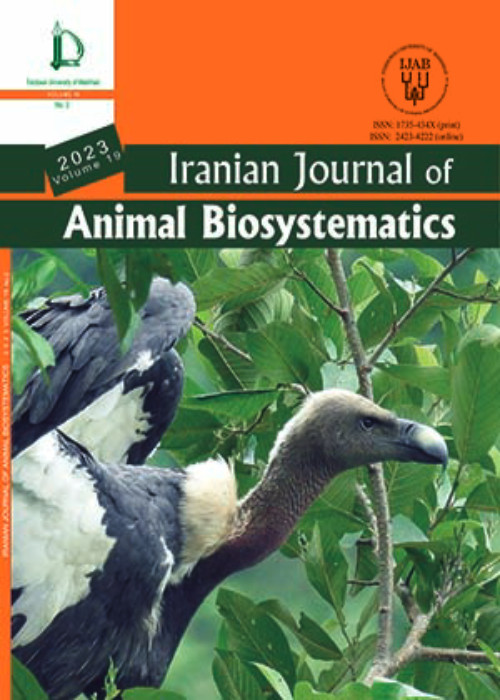فهرست مطالب

Iranian journal of animal biosystematics
Volume:15 Issue: 1, Winter-Spring 2019
- تاریخ انتشار: 1398/08/21
- تعداد عناوین: 8
-
-
Pages 1-8
Scorpions (order: Scorpiones) are widely distributed predatory arachnids and highly resistant to environmental conditions. Some factors such as microorganisms of internal cavity of scorpions may affect their biology. In addition, microbial communities of gut effect on immunity system and nutrition in arthropoda. However, few data are availablefor the microbiota diversity of scorpion gut. Thus, the present study aimed to evaluate the microbial diversity of scorpions related to the Buthidae family which is considered as the most important scorpions from south-west of Iran by chemical test and sequence analysis of 16S rRNA gene. To this aim, both gram positive and negative bacteria were detected from the gut of Androctonus crassicuda, Hottentota schach and Mesobuthus epeus. The staphylococcus saprophyticus, Bacillus cereus, Bacillus firmus, Corynebacterium variabilis, Pseudomonas putida, Pseudomonas oryzihabitans, Enterobacter aerogenes, Pantoe aagglomerans, Serrati aureilytica, staphylococcus gallinarum were isolated from the gut of scorpion. The isolated bacteria may have symbiotic or pathogenic relationships with scorpions. The present study was first considered the gut of buthide scorpion of Iran and can provide a reference for future studies on the digestive system microbiota from other scorpions by determining the role of these bacteria in the biology of scorpion.
-
Pages 9-46
An annotated checklist of marine brachyuran crabs from Gujarat waters is prepared based on past and recent literature. In total, 152 species from 87 genera and 29 families of brachyuran crabs including four new records and two revisions are listed. Gulf of Kutch comprises higher species diversity in comparison to Saurashtra coastline and Gulf of Khambhat. Dorippe quadridens (Fabricius, 1793), Lyphira perplexa Galil, 2009, Lewindromia unidentata (Rüppell, 1830) were reported for the first time from Gujarat whereas Planes major (MacLeay, 1838) was from Gujarat and India. Matuta victor (Fabricius, 1781) and Portunus segnis (Forskål, 1775) formerly misidentified in Gujarat waters are revised. Taxonomic description, habitat and distribution status of these species are presented.
-
Pages 47-59
Nemacheilian loaches are a group of freshwater fishes which are distributed in many inland waters of Iran. They are complex species from aspects of systematic and many species of this family are morphologically undistinguishable. Therefore, due to limitations behind the morphology-based identification of such species, genetic approaches such as DNA barcoding can be helpful to distinguish species, although their genetic relationships are not well determined yet. The present investigation provides data on genetic structure of some species of Nemachilidae including Paraschistura bampurensis, Oxynoemacheilus kiabii and Turcinemacheilus saadii from inland waters of Iran. These species were sequenced for a 652 base pair region of the mitochondrial cytochrome oxidase subunit I gene. All species were identified by cytochrome oxidase subunit I gene sequence. The sequences of P. bampurensis showed that specimens collected from two streams (Shapour and Fahlian, south-west of Iran), with 1.89% within-species Kimura two parameter distance, shared haplotype in neighbor joining tree. The results provided the first genetic evidence for O. kiabii, which has recently been recorded as a new species in Iran, and also cytochrome oxidase subunit I gene data showed that O. kiabii is completely different from other species of Nemacheilidae. The results suggested that cytochrome oxidase subunit I gene sequencing can be used to identify species of Nemachilidae from the Iranian streams.
-
Pages 61-75
Ektaphelenchus joyceae was repeatedly isolated from pine packaging woods imported from Korea and Japan to China. They are morphologically and morphometrically very similar and are characterized by having a total body length range of 539-718 μm, cuticle with fine transverse annuli and three lines in lateral fields, slightly offset lip region with six equally sized lips, hemizonid and excretory pore well posterior to metacorpus, 14.2-18.0 μm longstylet with visible lumen and lacking knobs, simple intestine ending in a blind sac, no visible rectum and anus, monodelphic-prodelphic reproductive system with small spheroid sperm cells inside the spermatheca, short post-vulval uterine sac (PUS) and lacking males. The recovered populations agreed well with the type population based on morphometric data and morphology of females. The molecular phylogenetic analyses were performed using small, large and internal transcribed spacer regions of ribosomal RNA genes for the first time and the feeding habit of the species was also observed and documented.
-
Pages 77-86
Bed bugs are regarded as one of the most important pests in human societies. Cimex hemipterus (Fabricius) is a parasite of humans and bats across tropical areas of the world. In the present study, the nymph and adult specimens were collected from residential buildings in central and western parts of Iran. Samples were identified using a diagnostic key at the species level and confirmed by molecular studies. Phylogenetic analysis using COI gene was also carried out. This study is the first report to have confirmed the presence of C. hemipterus in Iran.
-
Pages 87-98
The minute pirate bugs (Hemiptera: Anthocoridae) are an important group of natural enemies for biological control of many pests such as aphids, whiteflies, thrips, and spider mites. In this study, biodiversity of anthocorid bugs was studied in three geographical localities of Lorestan province (Khoramabad, Veisian, and Borujerd) during March 2014 to June 2016. A total of seven species, including Anthocoris pilosus (Jakolev‚ 1877), Orius albidipennis (Reuter, 1884), Orius laevigatus (Fieber, 1860), Orius minutus (Linnaeus, 1758), Orius niger (Wolff, 1811), Orius pallidicornis (Reuter, 1884) and Orius vicinus (Ribaut, 1923) were identified. We calculated the Shannon-Wiener index as 1.197, 0.939, and 0.898, the Simpson's index as 2.96, 1.75, and 1.75, and the Margalef's index as 0.66, 0.85, and 0.88 for anthocorid communities in Khoramabad, Veisian, and Borujerd, respectively. The biodiversity indices varied significantly in different seasons. The highest and the lowest diversity and abundance were recorded in summer and winter, respectively. The diversity indices were not statistically different between intensified (crop fields and orchards) and natural (rangelands and forests) habitats, though bugs in intensified habitats tended to have higher frequency and diversity than natural habitats. This study may provide useful information about species frequency and biodiversity of anthocorid bugs in Lorestan province.
-
Pages 99-105
In this study, the nest-cavity characteristics of Middle Spotted and Syrian Woodpeckers as well as tree characteristics (i.e. tree diameter at breast height and hole measurements) chosen by each species were analyzed. Our results show that vertical entrance diameter, chamber vertical depth, chamber horizontal depth, area of entrance and cavity volume were significantly different between Syrian Woodpecker and Middle Spotted Woodpecker (P < 0.05). The average tree diameter at breast height and nest height between the two species were not significantly different (P > 0.05). For both species, the tree diameter at breast height and nest height were not significantly correlated. The directions of nests entrances were different in two species, not showing a preferentially selected direction. These two species chose different habitats with different tree coverings, which can reduce the competition between the two species over selecting a tree for hole excavation.
-
Pages 107-116
The present study, during 2010-2011 was carried out in Torbat-e Heydarie (Razavi Khorasan Province). Adult speciemens were collected randomly with butterfly net. A totally, 28 species belong to 14 genus, two subfamilies were identified. All species are recorded for the first time from the studied area.


